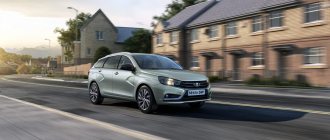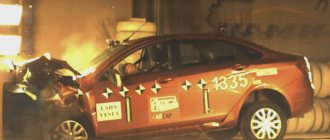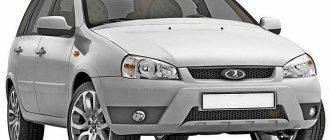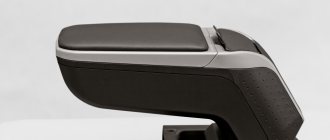Today it demonstrates enviable progress, delighting its fans with new and promising models that can successfully compete with foreign cars. A striking new product that has been seriously talked about in the global automotive arena is the Lada Vesta. Only the best constructive ideas and solutions that can be found today among foreign manufacturers are reflected in this “Russian”.
Probably, many will be interested: where is the Lada Vesta car assembled? In what city? Therefore, today we will talk specifically about this topic.
Start of production of Lada Vesta
September 2020. A model still unknown to the general public, the Lada Vesta, is launched into production. After a couple of months on the assembly line, the first copies appear on sale. Experts are very skeptical about the start of implementation, predicting the Lada Vesta will be the same failure as its predecessors.
However, over time the picture became completely different. Lada Vesta began to be bought up in large quantities, which became a reason to compare it with the best foreign cars on the market in the budget niche.
How did the manufacturer manage to succeed so much? It's simple: thanks to high consumer qualities, including:
- affordability;
- ergonomic and cozy interior;
- competitive and attractive exterior;
- capacity;
- the presence of modern assistant systems (ESP, ABS, etc.);
- fairly high degree of safety (2 airbags).
Where is the people's car assembled? Novaya Vesta is produced in Izhevsk. It also produces the Granta in the liftback version. The production of the new model was not without the participation of Renault engineers. They assisted in the design of the body, which was recreated using modern software. As a result of this interaction, Vesta’s body frame is not inferior in strength to the famous Ford Focus. The first crash tests have already confirmed this fact. In what city is the popular car in Russia still assembled?
Assembly and painting of a domestic model
Where is the car assembled and finalized? Welding of the main body elements is carried out using advanced robotic equipment. Although this process minimizes the influence of the human factor, it could not be done without the presence of qualified assemblers. Each stage of the assembly line takes place with the participation of workers. They hang the body panels, attach the remaining frame elements, which are subsequently welded using robotic technology.
Previously, the quality of painting of domestic bodies caused a lot of indignation among buyers. Today the situation is different. For painting Lada Vesta Cross purchases materials from global manufacturers - leaders in this market segment. Technological methods of painting, drying, polishing and other processes are constantly being improved.
The welded body is initially dipped into a special tank filled with an anti-corrosion solution. Then comes the stage of treatment with catapharesis primer. A significant proportion of these manipulations are performed by automation, but qualified painters perform their work in those places where clumsy robotics cannot get close.
The final stage for Vesta
- At all stages of the production cycle, continuous supervision is carried out by engineering and technical personnel. The quality of a particular operation is checked.
- The developers took quite a lot of care about the level of equipment and the quality of the interior. Here you can see soundproofing and anti-vibration materials, which are present not only on the panels, but also applied to the bottom.
- The final stage of the assembly cycle of the Lada Vesta Cross today is little different from a similar process among foreign automakers. Upon completion of the painting work, the doors are dismantled again and sent to a special workshop, where they are finalized to a finished state.
- After installing the headlights, bumpers and other components, the body is mated to the suspension, powertrain and transmission line. Note that, in part, domestic developers use the foreign experience of world leaders in the auto industry.
- Today, the manufacturer does not intend to stop there and promises to expand the line with the introduction of a hatchback and a station wagon, in the same place where sedans are already produced.
Let's sum it up
Many will ask: does the Lada Vesta Cross plan to be assembled somewhere other than Izhevsk? Yes! Assembly production at ChechenAvto is being established. The company is located in Argun. Also, Kazakh colleagues will soon begin cooperation with Tolyatti residents, since assembly will soon begin in Ust-Kamenogorsk at the facilities of BipekAvto, where other cars are also produced. Now you have become familiar with where Vesta is collected.
So, according to experts, today’s strategy of the Russian auto giant is correct, and it is not known in what city the model will be assembled in the future!
Hi all! Many people still wonder where the Lada Vesta Cross is assembled? Despite the fact that sales of the new product began in the fall of 2020, most still did not know the answer to their question. And this is a very pertinent question. If previously you only had to regret that Russia has so few cars of its own, now you can be proud that the new station wagon turned out to be successful and managed to make quite a splash among the public.
Addition: review of Lada Vesta SV Cross Station Wagon
Good day everyone. Well, after a short acquaintance with the Lada Vesta Cross SV, which was successfully sold in 1 day after three months of ownership (my review about it is on this portal for anyone interested), I decided to switch to Mazda again, this time CX-5, I drove the first generation CX-9 for 3 years before Vesta, so the comparison will mainly be with it, which is quite logical. A few words why Mazda. In fact, there were several main criteria: 1. The power of the car should not exceed 200 hp. (tax), and not 150 hp. — otherwise the difficult crossover will be vegetable; 2. All-wheel drive; 3. Automatic transmission; 4. As funny as it may be, the presence of a plastic body kit all around with the obligatory condition that the body kit covers the sills from the outside (the short operation of Vesta was overshadowed by the daily dirtying of the clothes of the whole family and a spoiled mood); 5. Atmospheric non-turbocharged gasoline engine; 6. Cost no more than 1 million rubles; 7. At the same time, the car should not be either Chinese or German (I think people will understand me). I didn’t have to think long, because from owning the CX-9 I was left with only the best impressions, especially since my colleagues and neighbors had CX-5s for several years already, I had the opportunity to take a ride and, being in constant interaction, hear and compare the opinions of the owners, as they say from firsthand I also considered the option of purchasing a Qashqai-2, but in the end I refused because of the CVT. There are enough offers on the market, but for myself I have already decided to take exclusively with a 2.5 l 192 hp engine, in the maximum configuration, preferably with two sets of winter/summer wheels, from under one owner and with the lowest possible mileage, and as much as possible fresh, and did not exceed 1 million rubles)). I’ll say right away that the task was not an easy one). Basically, the secondary market is dominated by offers with a 2.0 liter engine, besides, in order for ALL the required conditions to coincide, it was necessary to monitor the Internet quite closely every day, call/write to the owners of the cars being sold almost throughout Russia, excluding the Far East and the Far North. And so the car was chosen (it turned out to be a worthy option in Perm), purchased and driven in at the beginning of May 2020 - 2013; in original paint, max. equipped with a black leather interior (except for the sunroof), 2 sets of wheels - summer 19”, winter 17”; 2 sets of mats (rubber rubber and + textiles) with a mileage of 66 thousand km, I paid 995 thousand rubles for it. I took it to a friendly service center to have the chassis troubleshooted, everything is perfect, NOT ONE recommendation for replacement, even for small things! So, let's move on to the comparison. The first impressions are the most vivid, the car drives and handles just great and is very exciting! Acceleration is instant and very confident, faster than the CX-9, that’s for sure, less than 8 seconds to 100 km/h according to measurements from reviewers) At the same time, in comparison with the “big brother” it rides noticeably softer. In reality, there is always a sufficient reserve under the gas pedal, I also really liked the operation of the 6-speed automatic transmission - the reactions to switching are instantaneous, no hesitation.
Production and assembly of Lada Vesta SV Cross
Lada Vesta Cross is assembled in the city of Izhevsk at the LADA plant (formerly the IzhAvto plant). Many people think that it is going to, but it is not so. In 2017, the plant was renamed and is currently a subsidiary of AvtoVAZ. At the moment, in addition to the Lada Granta, the Liftback and the Lada Vesta sedan are produced. I would like to draw your attention to the fact that the plant carries out not only assembly, but also other production cycles, such as the production of body panels, stamping, painting, welding and plastic casting.
The body of the Lada Vesta Cross SV is assembled according to modern standards and using high-precision equipment. In terms of safety, Vesta Cross is not inferior to foreign brands, which has already been proven.
Assembly steps
After all the parts are stamped and ready, the body is assembled. Special robotic technology is used for assembly, but human intervention is not yet possible. Where the Lada Vesta Cross is assembled, a person is present at every stage of assembly.
When the body panels are hung on the body, it begins. First, the entire body is completely dipped into a special solution, after which it is covered with soil. Next, the robot paints the entire body. In the final part, the body is sent to quality control, where all paint flaws are manually eliminated.
After assembling the panels and painting the body, the car goes to a special conveyor, where it is gradually weighted with parts. At the stage of assembling the interior, the doors are unscrewed for convenience, and after completion of the work they are hung back in place.
Next begins the installation of external mirrors, headlights, radiator grille, moldings, etc. At the final stage, the chassis is connected to the power plant. At this point, we can say that the assembly of the Lada Vesta SV Cross is completed.
Is it worth buying a new Lada Vesta SV Cross?
This article will tell you why you need a new Lada Vesta SV Cross and whether it is worth buying it, and in what case it is needed. And if you already own a Vesta sedan, and you are completely satisfied with its body type, then making a sudden move now to sell your Vesta and buy a station wagon probably makes no sense.
Indeed, there are many pleasant developments here, another thing is that globally this car has not changed in any way. The gearbox, motor, drive can be considered global changes, but this did not happen. Then, with all-wheel drive, this car can be called a crossover, then the competitors will hold on, then in large cities they will not be afraid and will not hesitate to buy this car. In the meantime, the target audience of Vesta SW CROSS clearly does not live in Moscow
Finally, AvtoVAZ made a beautiful car. Who will ask, isn’t it a pity to pay so much money for a Lada? Think about it, what kind of station wagons do we have for money of about 800 thousand rubles? But it turns out that we have practically nothing new. Very decent handling, a car in such a budget rarely drives so pleasantly and recklessly. Visually the car turned out very well, it’s stupid to argue with that, it’s quite nice.
Another thing is that everyone was waiting for her for so long that many had rather high expectations. A crossover, everyone was waiting for a crossover, but in fact you shouldn’t expect a crossover from this car, it’s ridiculous. This is just a station wagon, with a slightly increased ground clearance, which is 203 mm and has a plastic body kit. Raised ground clearance gives us very little. In order to drive off-road you just need to lose your head. A black skirt will simply allow you to not rip off the beautiful body so much at the bottom, but otherwise the rubber will clog and all you get is the car sitting on its belly.
Now let's look at another aspect. The fashionable name for sport is vegan. But where is the declared sport? The 1.8 engine is not new. Now, according to reviews from the owners, this unit eats up oil, which, of course, the owners in most cases do not like. It turns out that all the sport has gone into the appearance of the car and that’s it.
For the first time, car enthusiasts were heard and disc brakes were installed in the rear, since many were indignant about what kind of drums were on the back, supposedly this is the last century. Nobody argues that disc brakes are cool. And the rims on the seventeenth wheels are very beautiful. If we talk about the appearance of the car, no matter where you look, everything pleases the eye. Here we must pay tribute to the developers.
Now let's analyze the trunk, it is quite roomy, it is simply impossible to find flaws in it, which no one expected from a Russian car. In the trunk there is a neat mesh, a very nice covering, an organizer, you lift it up, there is also a niche under it, a full-fledged spare wheel, another niche, a cigarette lighter, hooks, and what not there, even handles on both sides, everything is pleasant to hold, nothing dangles and does not wobble.
This new AvtoVAZ product cannot be compared with the Lada Priora and Lada Kalina 2. When the Vesta got a subframe, it divided these cars into before and after. As for tuning. If earlier, when buying the same Priora, you had to invest in the engine, brakes, and suspension. Here you can only invest in the engine, in the dynamics, and do everything to make the car go faster. There is good suspension, a normal gearbox, although I would like a sixth stage. Previously, AvtoVAZ did not pay attention to your wishes with us. Those who lacked light from behind now have a lampshade. An armrest with two cup holders appeared. Sitting in the back of an AvtoVAZ car, you now feel like a human being. And in winter you feel like a person with a warm bottom, there are heated seats, four airbags, and a cigarette lighter. For a B class car, the seats are quite comfortable, more or less with a high ceiling, and there is quite a lot of space in the cabin. The armrest is attached with a magnet. Separate glass heating appeared. A lot of Korean electronics are present.
You need to take the St. Cross only if you visually like this car with different bumpers and different linings. If you think rationally, take just a St., just a station wagon, this car still does not have any off-road characteristics, and at the same time a station wagon will cost at least 650 thousand rubles, which is a hundred thousand less than a St. Cross.
Where else can Lada Vesta SV Cross be assembled?
In addition to the former, the assembly of the Lada Vesta SV Cross is planned to be organized at, located in Argun. And the third, which is located in Kazakhstan in the city of Ust-Kamenogorsk. Lada Vesta Cross will be the first AvtoVAZ model to be produced at three plants at once in 2020.
The start of production of Lada Vesta took place on September 25, 2020, the model went on sale on November 24 of the same year. Initially, sales of the model did not inspire optimism. But now Lada Vesta is turning into a real market bestseller. Sales of the new Russian sedan are growing every month. Today Vesta competes on equal terms with the leaders Hyundai Solaris and Kia Rio. In addition to a good design, reasonable price, decent comfort and spaciousness, the new AvtoVAZ product turned out to be a fairly high-quality car. Today we will tell you in detail how the Lada Vesta is assembled.
But first, let's answer the question of where Lada Vesta is assembled
? The assembly of the new Russian sedan has been established in Izhevsk (Udmurtia). The Lada Granta in the liftback body is also assembled there. Ironically, back in Soviet times, the first liftback in the USSR was produced there. Yes, the legendary IZH Moskvich Combi was made there. This is a modern production facility where the Nissan Sentra sedan and Nissan Tiida hatchback are assembled in parallel (and are constantly suspended due to the crisis). The equipment, and the workers themselves, are somewhat different in Togliatti and Izhevsk. There is a difference in quality between the Togliatti-assembled Granta sedan and the Izhevsk-made Granta liftback.
Lada Vesta body
designed using the best software products and with the participation of French Renault engineers. Therefore, the power structure turned out to be very rigid. In terms of torsion, Vesta’s body is three times stronger than that of the Samar family (2108-2109 and other modifications) and two times stronger than that of the Lada Grant. According to this indicator, the domestic sedan is on par with the Ford Focus. The first crash tests showed that in terms of passive safety, Vesta is better than the Korean twin brothers Hyundai Solaris and Kia Rio.
Assembly
Compared to previous AvtoVAZ models, the Lada Vesta has made a very serious step in the quality of assembly and interior decoration, but is still inferior in this regard to many foreign brands. Owners complain about squeaky door hinges. This problem manifests itself over time and seriously spoils the impression of the car as a whole. This also applies to the mechanism for raising and lowering the windows, where the resulting play leads to scratches on a smooth surface. Also, extraneous noises arise from the stabilizer struts; they are heard especially clearly when driving on uneven roads. In general, the car's suspension is quite stiff, which does not add to the comfort in the cabin.
How to assemble the Lada Vesta body video
Avtovaz, to the delight of fans of the new car, published a video of the Lada Vesta body assembly. Of course, not all operations are carried out with the help of robots, but the main operations for welding power elements are entrusted to them. Next, watch the video.
There have always been complaints about the painting of bodies of domestic cars. However, recently Avtovaz has been solving this problem. Cooperation with the Renault-Nissan Alliance allows us to obtain new technologies and materials. As for the Izhevsk production of Lada Vesta, catafaresis soil is used here. Naturally, the body is dipped into a special bath before painting. But as in the case of welding, the process is not 100% automated; some of the work is performed by ordinary painters, who also monitor the quality of the paintwork. In some cases, human hands are faster than robotic machines.
The durability of the entire car and the preservation of its presentation largely depend on the quality of painting. According to this indicator, Lada Vesta meets all Renault-Nissan standards.
Lada Vesta SV Cross off-road video
AvtoVAZ states that the LADA Vesta SW Cross is a car designed to be not only on the road, but also off it. To make sure of this, it was decided to test the cross-country ability of this elevated station wagon on light off-road conditions. What do you think, will this car cope with the tests without all-wheel drive?
The main differences between the Lada Vesta SW Cross (an off-road station wagon and a regular one):
- Increased ground clearance (203 mm), like a crossover.
- Different shock absorbers and springs, different suspension settings. The track is 14 mm wider.
- Original plastic body kit.
- Wheels R17.
- and so on (not related to cross-country ability).
How to paint the body of a Lada Vesta video
Quite a lot depends on the final assembly of any machine. After all, there are a huge number of small operations that are performed by completely different people. If a person skips some kind of operation, then the future owner can then spend a long time looking for what rattles, creaks or sparks in his car.
I’m glad that before assembling the interior, they put quite powerful noise and vibration insulation not only on the bottom and engine bulkhead, but even in the trunk and on the roof. A simple piece of additional sound insulation can provide a decent amount of comfort, especially for people who spend quite a lot of time in the car.
Final conveyor assembly of Lada Vesta video
The assembly technology is no different from the same procedure when assembling a foreign car. The doors are removed from the painted car and sent for additional assembly. The absence of doors really helps put the interior together. The chassis and power unit are encountered almost as the last thing in the car. But the headlights are installed almost immediately. If you carefully examine the following video at 7 minutes, you will notice how easily and naturally they fasten the front part of the car (bumper with radiator grille). Apparently, the design of the front part of the body is generally a gift for car mechanics. After all, for wide access to the power unit, you can simply remove the bumper and radiator, which is somewhat reminiscent of the design of some Audis.
But the sedan is not the only modification of the Lada Vesta. Soon they will start producing cars in the station wagon body, and a little later in the hatchback body. The Lada Vesta Cross and Sport versions will appear in the near future. In addition to the 1.6 liter engine with 106 horsepower, the family of the new Russian car will receive a more powerful 1.8 liter engine with 122 hp. By the way, the Vesta Sport modification will also have two types of engines, these are forced 1.6 and 1.8 liter units that will produce 140 and 150 hp. respectively. Front-wheel drive is available with a 5-speed manual or 5-speed automatic transmission. Expanding the model range with new versions of Vesta will certainly help Avtovaz reach the planned production level of 100 thousand cars per year in the near future.
The Lada Vesta sedan has been quite warmly received by Russian car enthusiasts. VAZ wanted to wait for the reaction of the buyer of the Lada Vesta in a regular body before the sw cross went on sale. The reaction was positive, so there was no question of the model appearing in an alternative body version. There was only one question: when will this happen? On June 23, 2020, the premiere of the Lada Vesta SV and its “elevated” version “cross sw” took place, sales of which began 4 and a half months later - on October 25. The list of available engines for the new Lada vesta includes 2 petrol units with a volume of 1.6 liters and a power of 106 hp. and 1.8 liters with 122 hp output, available both with a “robot” and with classic mechanics. The new VAZ products were also well received by customers, because it turned out that since the times of the Soviet Union, “a lot of water has already flowed under the bridge”, our compatriots are finally beginning to appreciate all the delights of universal ones. A practical option for traveling along our “destinations” was the SV cross version, which combines a practical station wagon body with increased ground clearance. The assembly of new products is carried out in Izhevsk.
Lada Vesta SV Cross AMT (robot): reviews, video, overclocking
At the end of 2020, the brainchild of AvtoVAZ went on sale - the new LADA Vesta SW Cross station wagon, which has already made quite a stir. People are interested and search for information on the Internet, look at reviews, stand in line at car dealerships... And for good reason. The car turned out to be very beautiful and inexpensive, unlike its predecessors.
But it so happened that Vesta did not receive the classic machine gun. AvtoVAZ explained this by saying that the refusal to use automatic transmissions is due to cheaper designs. Installing an automatic transmission would entail an inevitable increase in costs. But, as an alternative, the AMT Lada Vesta Cross was chosen.
In addition to the robotic gearbox, a traditional 5-speed manual will also be available. But today we are not talking about her. Before starting the article about the Lada Vesta SV robot, I will make another reservation. Both transmissions presented will work together with 1.6 liter gasoline engines with a power of 106 hp. and 122-horsepower 1.8 liters. The robot will only be installed in conjunction with a 1.8 liter engine.
Number of cars produced
Since the official start of sales of the Lada Vesta station wagon, the plant has not had time to assemble the necessary configurations, and the stocks of ready-made Vestas in dealer warehouses very quickly ran out. Sometimes the queue of clients reached more than 3 months, and dealers, as always, tried to sell happy customers as much additional equipment and services as possible (some, without a hint of embarrassment, refused to give the already pre-paid copy to the owner if he did not follow the seller’s lead.) Now it’s the turn. has decreased, sales of the Lada Vesta of all modifications are growing. Since the onset of 2018, 24,300 copies have been sold, more than half the result of the same period last year.
Stabilizer struts Lada Vesta
In the rear suspension of the Lada Vesta SV Cross, these elements do not boast of their reliability, and therefore, the owners “transferred” them to the category of consumable components. After the 3,000th mileage, they begin to knock. The rubber bands of the stabilizer can also remind themselves of themselves, annoying the owner with an annoying squeak on uneven surfaces.
Start of production and start of sales
The Lada Vesta, whose sales as a sedan exceeded all expectations, has also found many buyers in its new version. They waited for its appearance on purpose, did not buy a sedan, and now their expectations were embodied in plastic, rubber, glass and metal. Vesta sw and its cross-country version began to be produced at the Izhevsk plant at the end of June 2020, and sales started 4 months later, when the date October 25 began to show off on the calendar. On the same day, the cross version also went on sale, as previously planned, judging by information from official sources. At first there weren’t enough cars for everyone; new modifications were quickly sold out from official dealers. Most of the cars that have not yet been assembled were purchased through pre-orders. There were advertisements from resellers selling purchased new cars at a significant markup. After a couple of months, the excitement began to subside and station wagons began to appear for free sale in showrooms. For the first time, VAZ correctly calculated the marketing and released the right model at the right time? At least, previously VAZ could not even have dreamed of a significant demand for products (after the release of Vesta Cross). How long will this last? We will find out the answer in a short time, but for now all that remains is to observe the events taking place and rejoice in the success of the domestic manufacturer. In addition, not so long ago (April 10, 2018) in Kazakhstan, AvtoVAZ’s largest foreign market, sales of new “universal” Lada models started, their production was established at the Asia Auto plant in Ust-Kamenegorsk. Various configurations (similar to Russian ones, so we won’t focus on them) are already available for ordering and purchasing in 19 cities. Sales are carried out by branches.
Release date of the Lada Vesta station wagon
Surprisingly as it may be, station wagon cars are slowly beginning to displace their analogues in the body style from their homes in the Russian market. The official start of sales of the Lada Vesta Cross all-terrain station wagon, together with its lower “brother,” began much later than the initially promised (after the sedan’s premiere) dates. Plans for exit were not destined to come true. Some buyers waited patiently, while others bought cars of various makes and models. Despite all the problems that arose, the launch of a new body for production became another successful step of the Russian auto giant as part of the Renault-Nissan concern.
The main differences between the cross version and the station wagon
How strong are they, and how did all this affect the rise in prices of domestic automotive products? Let's figure it out together
The all-terrain vesta has only 1 trim level called “Luxe”:
- increased by 2 and a half cm (203 vs 178 for a simple SV station wagon);
- slightly different interior design;
- a branded color exclusive to the cross version called “Mars” is available;
- 4 airbags (2 front and a similar number of side);
- A plastic anti-scratch body kit is installed on the arches and sills;
- 17-inch;
- driver assistants - ABS, ESP systems with anti-slip function;
- steering column with steering wheel adjustment in 2 planes (up/down, forward/away);
- heated front seats;
- driver's seat height adjustment;
- heated exterior mirrors with electric adjustment;
- heated windshield;
- climate control system and maintaining the designated speed;
- not a bad system with very decent sound;
- parking sensors;
- cooled glove compartment and other necessary things.
It is also possible to order additional option packages that add:
- heated rear passenger seats;
- rear sofa with armrest;
- interior lighting LEDs;
- radio with the ability to use a navigator; factory tinted rear windows;
- rear view camera.
The increase in price of the Vesta SW Cross compared to the “landed” “car” can be simultaneously called significant and also small: the maximum configuration of the Cross Vesta with a 1.6 engine on a manual gearbox will be about 780 thousand Russian currency. For the installation of a larger power unit, you need to pay an additional 25 thousand rubles and 25,000 for a robotic box developed by specialists from the Volzhsky Automobile Plant. The body paint is available in 9 color options, for metallic you need to pay an additional payment of 12 thousand. Do you want an exclusive color? Pay only 18 thousand extra and you will be the owner of a color with the interesting name “Carthage” (beige metallic).
Equipment
Buyers of domestically produced vehicles are already accustomed to the fact that even with the maximum level of equipment, they can only count on a radio and air conditioning. Lada Vesta has also made a serious step forward in this direction. Depending on the vehicle configuration, the owner receives:
- climate control function;
- touch screen multimedia system with navigation;
- rear view camera.
Of course, by European standards, all this has long become the standard equipment for a modern car, but given the fairly affordable price of the Lada Vesta, such a set of equipment cannot but rejoice.
Statistics of cars sold
The new model called “Vesta” has appealed to many car enthusiasts, as evidenced by statistics. Growing sales compared to 2017 only give VAZ management confidence, which is why they are trying to enter the European market. Until the end of April, “Vestas” will be available in station wagon body and “Comfort” equipment options with 1.6 liter engines. environmental class Euro 6 and any type of gearbox must reach car dealerships with a starting price of no more than 12,000 Euro. AvtoVAZ hopes for sales growth in Europe, because over the past year, 909 sold cars found their owners there.
Cross-country ability of Vesta
A car with the “cross” index has a stiffer suspension, which negatively affects the comfort of passengers and gives the driver a sporting desire to overtake the main stream; fortunately, the steering responds quite accurately. Stiffness is the result of tuning the suspension, original shock absorbers, and springs. When thinking about cross-country ability, you don’t have to worry about such “little things” as curbs; the car’s ground clearance more than covers it. The standard wheels are 205/50R17, which seem indecently large compared to other AvtoVAZ models.
Under light off-road conditions, the crossover shows a very decent class. The car demonstrates excellent traction with the ground, allowing all kinds of cobblestones to pass under the bottom. The engine power is enough for difficult situations; when slipping, the TCS system comes into effect, transferring the load between the wheels in a timely manner. When ESP is switched off, the speed is limited to 60 km/h.











